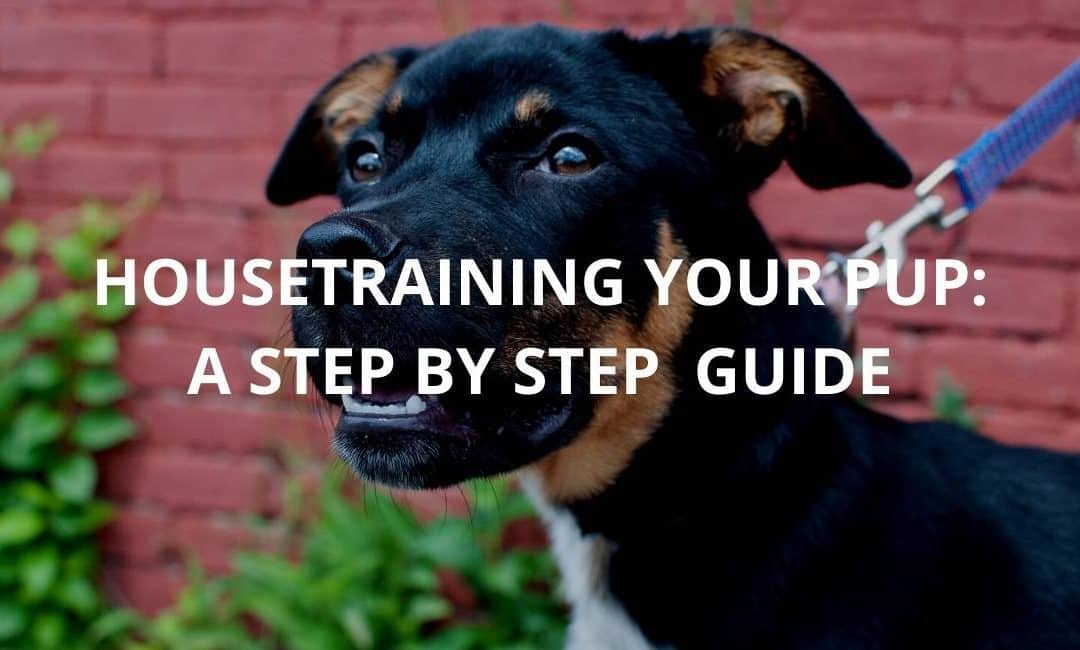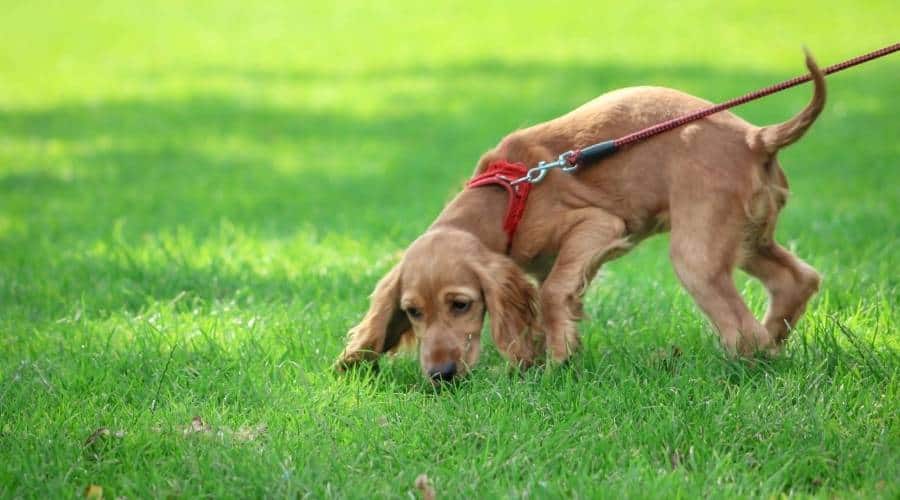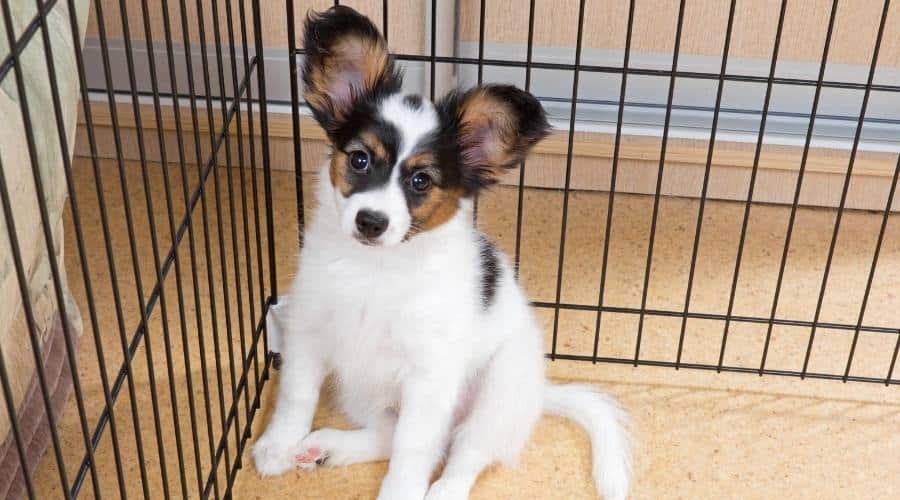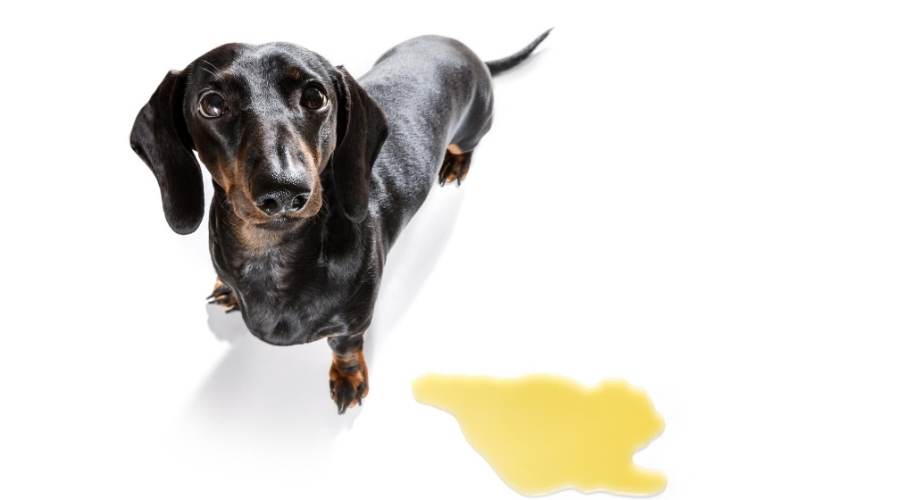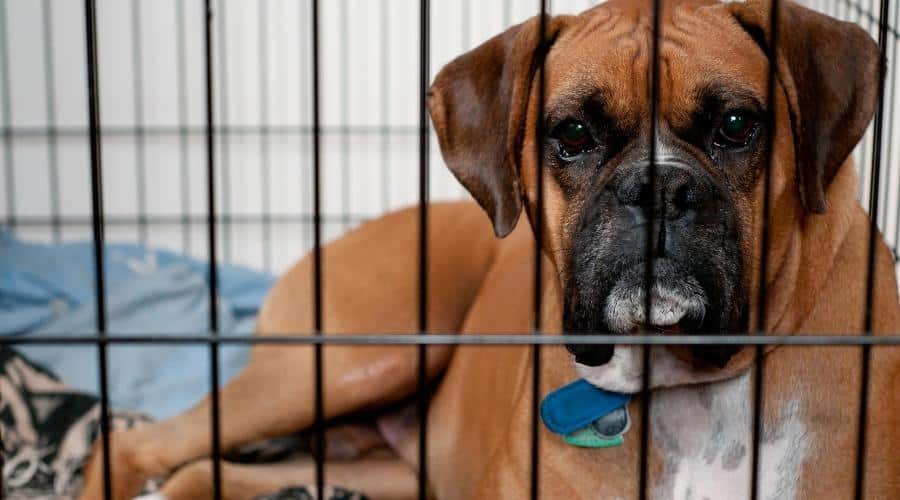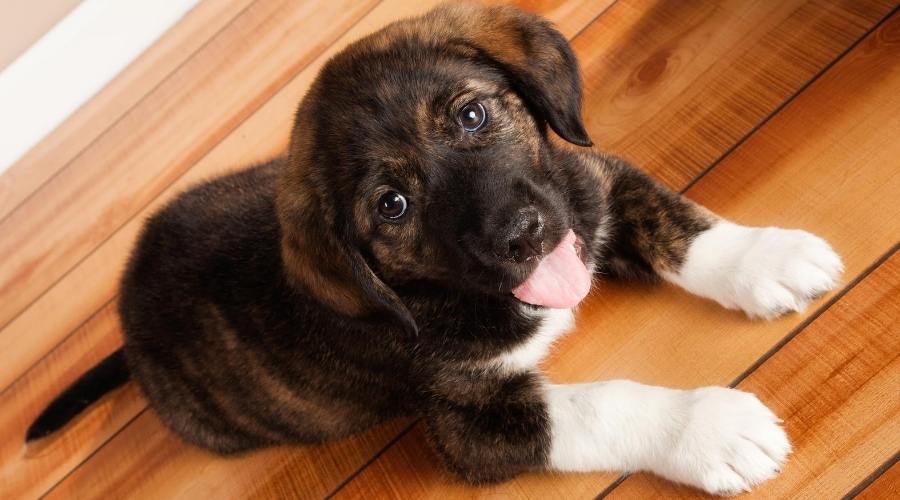Some puppies seem to housetrain themselves. This isn’t for them. 😉
This housetraining guide is a step by step resource for owners of a new puppy – or older dog – who want help getting their dog’s housetraining habits reliable.
I’ve never met anyone who didn’t want a reliably housetrained dog. Frankly, having a pup who understands where it can go and where it can’t is one of the most basic expectations of any new pup parent.
The good news is, there’s nothing mysterious or difficult about the housetraining process. The trickiest part is that it requires a firm commitment and everyone involved sticking to the plan. If you can manage that, you can housetrain your pup! Â
Introduction
When we housetrain, we’re teaching a dog where we want it to relieve itself. Where the dog’s bathroom is and where it’s not. Virtually any dog can learn this. However – and this is an important one – this is not something a dog knows by instinct.
What it does know by instinct is to avoid soiling its own sleeping area. Any puppy raised in a reasonable environment, with room to move around and leave its sleeping and eating areas when it needs to relieve itself, should have this instinct intact when you get him.
But the idea that the entire house or apartment is off-limits? Or that only certain parts of the yard are allowed as a bathroom? That’s a strictly human notion that you’ll need to help your pup understand.
Housetraining is training your pup to acquire the habit of being clean in the house. A habit is a “recurrent, often unconscious pattern of behavior that is acquired through frequent repetition†(as defined by the American Heritage dictionary).
This pattern of behavior is accomplished by creating – and sticking to – a schedule for your pup’s food and trips outside; teaching the desired behavior, and preventing accidents until the proper habit is firmly established.
As with any training you do with your dog, patience, persistence and consistency now will pay off with big rewards in the long run.Â
| Looking for a quick visual summary of this housetraining guide? Be sure to bookmark my Housetraining Checklist and Infographic. |
How long does housetraining a puppy take?
If you’re consistent with your schedule and stick with the plan, most new puppies and dogs can be successfully housetrained in 2 to 3 weeks.
This doesn’t mean you can leave your pup unsupervised or for overly long periods without bathroom breaks. But most pups will be able to get into the routine of going outside (and not inside) within that amount of time.
If you’re housetraining a puppy or older dog that already has a habit of having accidents indoors, it’ll take longer. How much longer will depend mostly on how long the bad habit has gone on. You’ll not only have to prevent the old (bad) habit, but establish the new (good) one.
Research tells us that it takes around 6 weeks to replace an old habit with a new one. So, be prepared to be especially diligent and consistent if your pup has taken to using part of the indoors as a bathroom.
Housetraining Program for Puppies and Older Dogs
First, Create a Housetraining Schedule
Schedule your pup’s meals
Your pup’s feeding schedule should be consistent until his housetraining is reliable. The number of times fed, the time of day fed, and the amounts should vary as little as possible. It’s also important to keep the dog food brand and formula consistent. Since sudden changes can create digestive upsets that wreak havoc with housetraining, this is not the time to be adding variety to your pup’s diet.
No free feeding
If you are planning to feed “free choice†meals to your pup, do not do so until your pup is thoroughly and reliably housetrained.
A pup that eats randomly, here and there throughout the day, will need to go to the bathroom randomly, here and there throughout the day.
This will make it much harder to predict when your pup needs to relieve himself! Make it easy on yourself and your pup; feed at regular, predictable mealtimes.
How many meals per day?
One of the best methods of determining how many meals to feed per day is to go by your pup’s own body rhythms. The rule of thumb is to feed as many meals per day as your pup has bowel movements.
As your pup matures, the number of bowel movements will reduce. Each time it does, reduce the number of feedings accordingly.
Schedule puppy bathroom breaks
The trips to walk your pup out to relieve himself should be as consistent and predictable as possible, at least until housetraining is reliable.
You will want to create a schedule that is convenient for you, one you’ll be able to stick to.
Keep in mind that while most dogs and puppies will be able to “hold it” for eight hours during the night within two to three days of coming home, daytime is an active time, and therefore a time of increased elimination.
Bedtime and waking-up times should be part of your pup’s schedule
Housetraining will proceed most rapidly if you stick to these times as closely as possible. Be sure to schedule nap times as well; young dogs need lots of these! Your pup will need to be taken out after naps, and immediately following each meal.
How often should a puppy go out?
Even a newly adopted 8 week old pup, provided he is in good health, can go at least 2 daytime hours between trips outside. Older pups can go somewhat longer.
For the first few months, one hour per month old is a decent approximate rule. So, a 3 month old pup should be able to go about 3 hours in between potty breaks.
This is one of those “depends on the dog†things, though. Tiny breeds have tiny bladders and fast metabolisms, and typically have to go more frequently than larger breeds.
Whatever your pup’s breed, as she matures and learns to go only outside, time in between trips will lengthen.
Not all bathroom trips will be on the schedule!
Be aware that physical or emotional stimulation may cause your pup to need to go. This might be after an exuberant play session, or if your pup is suddenly surprised or frightened.
You may not realize why your pup is sniffing and circling. It doesn’t matter. If in doubt, take him out!
If you always know where your pup is, and what he is up to, you’ll be able to catch him before he makes a housetraining mistake.
Teach Your Puppy the Housetraining Habit
Pick a bathroom (“pottyâ€) cue
You may not initially see the importance of a verbal cue for going to the bathroom. However, think about how helpful it would be to be able to have your pup “go†when asked, for instance if you have to leave for work early, and won’t be able to take him out at his regular time, or if you would like to be sure he goes before you take him inside at your friend’s home, or if you are stopping at a rest stop on a long trip, and it would be so very handy if your pup would go now.
Pick a word or phrase (such as “hurry upâ€, “go pottyâ€, “do your businessâ€, etc.) and use it consistently, and soon you can have a pup who can “do it on commandâ€!
Supervise, supervise, supervise!
Teaching your pup what not to do is at least as important as teaching the behavior you want. That’s why, for the puppy or dog in housetraining, there is no substitute for diligent supervision.
Simply put, if you always know where your pup is, and what he is up to, you’ll be able to catch him before he makes a housetraining mistake.
Where’s a pup to go?
There is no particular right or wrong place to teach your pup to use as his bathroom. It simply depends on what is convenient for you.
Bathroom areas can be as general as anywhere outdoors, or as specific as a certain corner of your yard. You must have a clear and realistic idea of what the area is – and the time you wish to put into the process – before you start teaching your pup.
Take your pup out
When you take your pup outside to relieve himself, keep in mind that a bathroom break is just that. This isn’t the time to play with your dog or chatter at him. Doing so will most certainly distract him, and make him think that trips outside have a different purpose.
Instead, take your pup out to the bathroom spot you’ve decide on, and wait quietly. Let him sniff around and find the perfect spot. If you’re unsure how long to wait before deciding he doesn’t need to go, pick a reasonable amount if time to wait. Four or five minutes works for me; you pick what works for you.
When he starts to go
Use quiet, gentle verbal praise while your pup’s in the process of going. Praise can include your exercise cue, along with “goodâ€. So, quietly repeat “good pottyâ€, or (if you’re like me) “good hurry upâ€, while your pup is going.
When he’s finished, go ahead and praise more enthusiastically, since at this point you won’t risk distracting him from taking care of business.
Treat or no treat?
While it’s not absolutely necessary, many owners find that a small treat given just after performing his duties outside can speed up the pup’s understanding of the housetraining process.
On the other hand, I know of many dogs housetrained with treat rewards that learn to ask to go out when they don’t need to, or even to squat and pretend to go (dogs can be so clever) in order to get a treat .
Using treat rewards for housetraining is a personal choice. Personally, while I use treats to teach and reward many behaviors, I don’t use them for housetraining.
If he doesn’t go when you take him out
It’s very important that, if your pup does not relieve himself when outside (when you think there was a pretty good chance he needed to go) you do not allow him free access to the house.
If he doesn’t go while you are out, return him to the house, but confine him for another 15-30 minutes before you try again.
Many pups will become distracted by the smells, sights, and sounds of outside, only to remember that they need to go once back inside. This mistake will quickly turn into a habit if not prevented. This is probably the most common housetraining problem of all!
Learn your pup’s bathroom habits
Every dog is different, and each will have his own bathroom habits you’ll need to learn. Some dogs don’t go all at once, but multiple times before they’re finished. This is true especially when it’s been awhile (such as overnight) since they relieved themselves.
Most pups will urinate before defecating, but some do it the other way around. Some will need a good run, or at least a long walk, before defecating. Many will defecate only after they eat, others before.
The important thing is to observe your pup and find out his tendencies. While you become familiar with your pup’s habits, stick to your schedule, taking him out as soon as he wakes up, after meals and immediately following all play sessions.
Prevent Accidents Until Housetraining is Reliable
When you can’t completely supervise
Lives are busy, and naturally it simply will not be possible for you to watch your puppy 24 hours a day until he is reliably housetrained. However, if you let your guard down and let him wander unsupervised, he will almost certainly have accidents in the house – and that good housetraining habit will take much longer to establish.
So what’s a new puppy owner to do? Be prepared!
Develop a system of other options to keep those accidents from happening, even when you might be busy or preoccupied, and not able to keep an “eagle eye†on your puppy.
Here are some ideas for keeping your pup from getting into trouble when you aren’t able to watch him closely:
- Put the pup on a leash, and hook the leash handle around a doorknob in the room you’re in. This is a good option if you are staying near your pup, so you can be sure the pup doesn’t chew his leash, or get tangled or caught up in it.
- Put him on leash, and attach him to you (for instance, you can hook the leash to your belt). This is a good option if you will be moving from room to room. This is also a great way to teach yourself to recognize your pup’s signals that he needs to go out.
- Place your pup in a pen or enclosed area that is small enough that he won’t want to soil it. Puppies and dogs have a natural instinct to have separate bathroom and living/sleeping areas. If the area is too small for both, they will avoid using it as a bathroom spot.
- If you have a small pup, you can carry him in your arms, or in a sling-type carrier (they make these for dogs, very similar to the ones people use for babies).
- You can put the pup in his crate for a nap.
- Or, you can put your pup in a safe, secure, outdoor enclosure.
If you’ll be keeping your pup in one spot for awhile, it’s a good idea to give him something to occupy himself with: a toy, chewie, or something similar. This will help create a habit of settling down, rather than fixating on you, or getting bored and fussy. After all, every pup needs to learn to settle politely when he doesn’t have your attention!
Home alone preparation
When you’re not home, your pup must be confined in some way so that he’s not able to have accidents in the house.
If your pup is not able to be outside in a safe, secure area while you’re gone, you will need to provide an indoor place for him to be. This does not need to be huge. In fact, a smaller area, with all chewable temptations removed, is preferable.
You can use a utility room, a small bathroom, a section of your kitchen closed off with baby gates, or a fenced-off corner of your garage or basement. (You may want to put down some papers or housetraining pads for your pup to use if he needs to.)Â A crate can be used if you are not gone for extended periods of time.
Wherever you choose to do it, when you leave your pup alone, be sure to provide some safe chew toys for entertainment. But avoid leaving food with your pup and large amounts of water.
Remember this rule: most puppies can be expected to be hold it for as many hours as they are months old, up to 7-8 hours. If you have a toy breed, be aware that tiny dogs can be an exception to this rule, as their metabolisms are faster, and accordingly they will need to eliminate more frequently than a larger breed dog.
If you’re gone for longer periods than your pup can handle at his age, please consider finding a person to come in and give the pup a bathroom break and maybe a drink at some mid-point during the day. This could be a friend or relative, a responsible neighborhood teen looking to make a few extra dollars, or a professional pet sitter.
Preventing overnight accidents
Most pups can learn to go overnight without accidents quite quickly, usually within days of being home. This is provided your pup is healthy and of sufficient age for bodily control, and (I bet you already guessed) you prevent accidents from happening at this time.
Where should your pup be overnight, to help prevent accidents? You have several choices.Â
In the bedroom with you. Shut the bedroom door, or use a baby gate, to keep him from wandering if he wakes up in the night. If he does wake up and needs to go out, you are more likely to hear him moving around if he is confined in the room with you.
If your pup is small, and the bedroom is large, you may want to tether him: have him on a 4-6 foot leash, and attach that leash to the foot of your bed, near a dog bed or blanket he can lie on. Tethering will prevent him from using a far corner of the room as a bathroom spot.
In his crate. If you do not have to use the crate to confine your pup for extended hours during the day, then a crate is a great place to teach your pup to sleep at night. While you can place the crate anywhere convenient to you, the best place to place the crate is right next to your bed, where you can hear him if he must go during the night.
Being in the bedroom while you are sleeping also helps the pup associate nighttime with sleeping. (It is much easier for a pup or dog sleeping in the bedroom with you to get on your waking/sleeping schedule.)
Confined in another, familiar, area of the house. Before dog crates came into popular use, probably the most traditional place to have a dog sleep at night was on his bed in the kitchen. If you are able to use baby gates to enclose your pup in the kitchen (or a part of it), this is a nice option for most people.
You can put down papers or housetraining pads in one corner of the room until your pup is capable of holding it overnight; if there is an accident, the floors are easily cleaned. And because this room is a high-traffic area in most homes, your pup will not feel as isolated as he might if shut in some out of the way part of the house.
Puppy Housetraining Accidents Will Happen: What to Do
If you catch your pup in the act
If your pup starts to relieve himself indoors, immediately tell him “NO!†in a firm, low voice, and quickly take him out to his bathroom area.
The idea is to interrupt him, so that you can get him out to his bathroom area, show him the correct place to go, and praise him for using it. It is not necessary or helpful to yell at the pup, chase him, or hit him!
Cleaning the accident
Because there is evidence that letting your dog watch you clean up his messes may actually slow the housetraining process, do not clean the accident in front of the dog.
Either leave your pup outside, or once you are back inside with your pup, put him somewhere so that you can clean the accident without your pup watching.
I can’t say enough how important it is that you completely remove all traces of scent from the spot. A dog’s sense of smell is almost unimaginably better than ours. It won’t matter if it smells clean to you – if it smells like a bathroom area to your pup, he will keep treating that area as a bathroom.
To remove scent, use an odor neutralizer or an odor-killing product. (You can find these products at your pet supply store or veterinarian’s office.) Soap and water generally won’t do the trick, although if you find yourself with a mess and no odor neutralizer, thoroughly cleaning (and soaking, if carpet) the area with white vinegar can be effective.
Just don’t use ammonia, since it’s chemically related to urine, and will leave the area smelling vaguely like urine to your pup (not good!).
If you find a mess later
First, keep in mind who is the teacher, and who is the student! Remember, a pup who is still in housetraining should not have been left unsupervised. You will want to clean the accident as described above, out of sight of your pup, and figure out what you need to do to make sure that kind of supervision mistake doesn’t happen again.
Please note that it is NEVER recommended that you yell at your pup, hit him in any way, or “rub his nose in itâ€. None of these methods will teach your pup how to avoid having accidents in the house.
They WILL teach your pup that you are an unpredictable teacher, and he will quickly make the association that if you and the mess are in the same room, trouble is on the way.
This association, and not spite, or even an understanding of doing something wrong, is the source of the “guilty look†some dogs will have when owners find an accident some time after it’s happened.
Important Note About Dog Crates
A dog crate (also known as a kennel, carrier, or simply a cage) is one of the greatest convenience items you can buy to help in the housetraining of your pup. Dogs are by nature “denning†animals: they prefer to seek out quiet, cozy places to rest. A crate acts as an indoor den – think of it as your pup’s very own bedroom inside your home.
Properly introduced to a crate, most dogs enjoy having their own private spot; many nap in it on their own when they have a choice of spots to sleep, and even “send themselves to bed†at night.
Another part of the denning instinct is a strong innate desire to keep the den clean. Unless a pup has learned otherwise, he will only use it as a bathroom if given no other choice. So, a crate is one method of confinement that also helps your pup learn to “hold it†for reasonable periods of time while you train him to a convenient exercise schedule.
In addition to housetraining, a crate has lots of other everyday uses. It can be your pup’s quiet, safe spot in the house, away from children, other pets, and puppy temptations. A crate is an excellent way to transport your pup in the car, keeping him protected from sudden stops. And if your dog needs to stay at the veterinary hospital or boarding kennel, there is a good chance he will spend some time in a crate – so it’s best to get him used to it now, so he can be comfortable and relaxed later.
While crate training is a wonderful tool for the new puppy or dog owner, just like any tool it can be improperly used.
Your pup’s crate should be his safe spot, and should never be used for punishment.
The crate is a training aid, and by itself won’t replace the need for supervision, scheduling, and teaching house cleanliness and manners.
All dogs – and particularly growing puppies – need to run, play, and stretch their legs frequently in order to develop properly both physically and emotionally. The crate should never be used to such an extent that your puppy or dog is unable to get the exercise and companionship he needs.
Keep in mind that the crate is only one tool. Use it with common sense, and in conjunction with other methods of confinement and supervision, and you will find it an excellent and useful part of your housetraining program.
Your Puppy is Almost Housetrained!
Okay, your new dog or puppy is on a consistent feeding and exercise schedule, and you’ve been diligent about preventing accidents in the house. His bathroom habits are becoming predictable, and you’re learning to recognize the ways he tells you he needs to go out.
Congratulations – you’re almost there!
Here are some final tips to help your puppy-in-training graduate to “reliably housetrainedâ€:
Adjust your schedule
Make note of when your pup relieves himself when he is taken out on his scheduled bathroom breaks. Begin to eliminate those breaks during which he never relieves himself. As your pup matures, keep making note of his habits, and adjusting his exercise schedule accordingly.
Give more freedom
It’s important to stay vigilant with your supervision, but now is the time to begin giving your pup some more freedom in the house. If you are sure your pup has definitely done his business outside, allow him a safe amount of time to explore the house without you on his heels. This is important to teach your pup that cleanness in the house is not something practiced only when you are in sight.
If your pup was outside alone
Don’t assume he relieved himself just because he was outside. Puppies, even grown dogs, get distracted by the sights and sounds of the outdoors, and sometimes forget to go!
If you didn’t actually see him go, be careful to supervise when he comes inside, watching for any telltale signs (circling, sniffing, etc) that he may still need to relieve himself.
Wrapping Up
For most puppies and newly adopted older dogs, following this basic program will get you well on your way to a reliably housetrained dog. It will even resolve existing housetraining problems with dogs that either never learned to hold it, or that “lost their housetraining” at some point.
And what could be better, and more fundamental, than that?! Â
I hope you enjoyed and found value in this article. If you did, please share with your friends!
Best,
julie
(bio)
